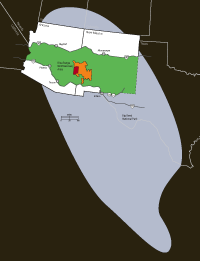Strategizing a Comeback
In 1982, U.S. and Mexican wildlife agencies adopted the Mexican Wolf Recovery Plan, which called for maintaining a captive breeding program and re-establishing a population of at least 100 Mexican wolves within a small portion of their historic range.
The Blue Range Wolf Recovery Area encompasses the Apache-Sitgreaves National Forest and the Gila National Forest, and is divided into Primary and Secondary Recovery Zones. This is the area where the re-established Mexican Wolf population is managed and maintained.
- Primary Recovery Zone: This area, in Arizona, is the only part of the Blue Range Wolf Recovery Area where captive-bred wolves (with no experience in the wild) may be released. Captive-bred wolves with wild experience can be translocated into the secondary recovery zone.
- Secondary Recovery Zone: This national forest land next to the Primary Recovery Zone is an area where wolves are allowed to disperse. Wolves with experience in the wild, as well as those born in the wild, may also be moved to and released in this zone.
- Experimental Population Area Boundary: This is part of Arizona and New Mexico south of Interstate 40 and north of Interstate 10, as shown. Wolves that move outside of the Blue Range Wolf Recovery Area are considered part of the “nonessential, experimental” population as long as they stay within the Experimental Population Area boundary. If a wolf is captured in this area but outside of the BRWRA, it will be re-released within the recovery area or put into the captive population. The Service will NOT release wolves outside of the designated Blue Range Wolf Recovery Area into this larger Experimental Population Area. Wolves found outside of the Experimental Population Area boundary are afforded full protection under the Endangered Species Act.
- Historical Range: Mexican wolves inhabited this entire area, from Mexico through southern Utah and Colorado, before the arrival of European settlers.
